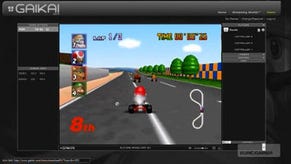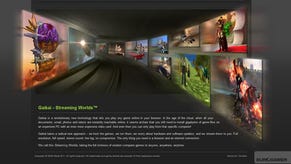Gaikai: Cloud Computing Gameplay That Works?
Eurogamer versus gaming over IP: round two.
"OnLive says it'll have five datacentres... Our strategy is to go much, much more denser than that," Perry continues. "We're going to be constantly adding datacentres. A good example of that is that we have a California datacentre right now, and that's an 800-mile round trip - about the length of England. That's what we did the demo on. But that's not the actual solution. The company we're planning to go with, the closest server they have to me is in Irvine. That's about 20-30 miles from my house. That went online yesterday and so yesterday I got to experience the final service, that's what I'm going to personally experience. I'm getting 5ms ping time... or rather, five there, five back... trust me you just don't feel it."
Gaikai co-founder Andrew Gault wades in with more evidence that the lag issue is over-stated, saying that the most popular console gaming system on the market today already has a big degree of latency already built in.
"The Wii controller in itself adds an extra 100ms," he says. "So even before the game gets the input, there's another 100ms getting the data to the console. It's very easy to get scared of a 100ms latency, or whatever, but really, most people play with far higher latencies than they think."
Perhaps the biggest surprise I had from a technical perspective talking to the Gaikai people was the fact that (hold on to your potatoes!)... it runs using Flash. The AVC codec we saw being used in the video demo is exactly the same as the one used to run our Eurogamer videos. It might sound like madness, but accessibility is the key to everything Gaikai stands for. No plug-in is required because Flash is handling everything
"Flash supports multiple codecs," says Perry. "We're doing a closed beta sign-up phase, and the beta does a calibration test on your machine. What we wanted to do was come up with a system that's codec-agnostic so we can change the system according to your bandwidth, your hardware, how much CPU you have, what kind of game you're running, what kind of application you're running."
"We do see performance differences between Flash on different operating systems, but all are easily capable of delivering a 30FPS experience on modern hardware," adds Andrew Gault. "For older PCs and netbooks we dynamically change the stream quality and FPS so that it will always run reasonably."
Just like OnLive, Gaikai uses technology similar to Microsoft's smooth streaming 1080p video delivery system, whereby the quality of the video dynamically adjusts according to the bandwidth available. In the case of the Microsoft system, multiple encodings of the movie are carried out and the server switches between them according to conditions.
"We do something very similar except we don't do multiple encodes of the source," explains Gault. "We can change codec settings on the fly. Or the codec itself."
And there's no lag, no blip in transmission, during the switch?
"Initially, when we did it through Flash there was a hiccup. So when you jumped codec, or settings, there was a 100ms freeze. Through reverse-engineering and headscratching we got through that. We can dynamically change the quality and the frame-rate that the user sees. The quality, based on the network and how that changes through the game and the frame-rate based on the PC. If you start up an MP3 or start a Skype video call, that takes quite a bit of CPU time, so we can drop the frame-rate to accommodate that."
"We don't want anyone to have a horrible experience," adds Perry. "When you first start up, it'll test your machine and if your bandwidth is all gone, or you're trying to play on a cellphone modem and it's really jumpy, it's going to tell you."
"Actually I did that last night," chimes in Gault. "My girlfriend has a 3G modem and I was playing Warcraft. It was a bit laggy but it was playable."
"We also want to make sure we're ready for WiMax when that becomes a standard," Perry continues, talking about the 'connect anywhere' wireless standard currently in development. "So you can play World of Warcraft in the back of the car."
"Realistically, there are no smoke and mirrors here," says Gaikai co-founder Rui Pereira. "I can tell you that there will be slightly more hiccups while playing over a wireless connection. It's simply unavoidable because of the jitter, but our point is that it should be good enough to be playable. You'll not be playing Crysis in HD at 60 frames per second though, that I can guarantee you."
Which dovetails quite nicely into the next of the technological hurdles we had a bit of a problem with on OnLive, the hardware encoder built in each of their servers which can apparently encode an HD frame in 1ms.
"We think it's important to use software encoders on the server CPU," says Gault. "The flexibility is very important as it lets us get anywhere - we can quickly add/change codecs in the future - and massively reduces costs as we can use generic hardware. Not to mention Moore's law is on our side. Most hardware encoders are designed for the broadcast market where adding a few tens or hundreds of milliseconds delay doesn't matter - so they all do. We have talked with these companies and it would be possible to get a sub 2ms encoder for a price; but if we can do it in software in 6ms it's just not worth the cost. No-one is going to feel 4ms [difference]."
Gaikai's approach seems to be not only to accept the technological restraints of so-called Cloud computing but to actively use them to bring gaming to a whole new audience. For example, the smaller the display window, the more "portable" the experience is and the more people will end up playing it. And while bizarro plug-ins often get blocked, everyone supports Flash. Gaikai's big idea isn't that it's going to use streaming video to replace conventional gaming hardware or to bring about a brand new era in HD gameplay, simply that this gives them the chance to bring people who might usually play Flash games into the clutches of game publishers like EA and Activision. And the size of this market is absolutely colossal.
"If you go to Kongregate.com, I've listed the top played games on their website and just on the first page, there were 61 million plays," notes Perry. "That's one of 20,000 Flash aggregator sites in the world. That's 61 million plays that the games industry missed out on. Those are people idly sitting at work, trying out games, and the most important things are that they're convenient to get at and they don't have to pay right away. Think of the Facebook audience, think of all those Facebook games. People playing Poker for god's sake... Mafia Wars. They could be playing the best games our industry can make, in less time than it takes to load a typical Flash game. What's why this is potentially a game-changer. And that's why it doesn't need to be HD, 60 frames per second."
One of the other key elements that surrounded my general scepticism of the OnLive concept was the idea of sheer costs involved in setting up the vast datacentres. The danger is that the units will be sitting there off-peak doing nothing, while there won't be enough servers to go around during peak periods or when a hot new game debuts for the first time.
"They're having to blanket the country with a massive server infrastructure to handle peaks... and they don't even know what those peaks are going to be yet," says David Perry. "Someone has to foot the bill for all of that. What we're doing is a completely different solution. Say you're going to Nintendo.com. We'll actually look at your geographical location, see we've got a server near you, and pop up a button that says 'play Mario Kart now'. You click the button, up pops Mario Kart and you can play it... Our objective is to make you fall in love with Nintendo and have a great time playing Mario Kart. And this is the big difference. We're not running the games, it's the publishers running the games. We supply the service to them to let them do this."
In short, there is no Gaikai subscription as such. The service is financed and run by the publishers, using Gaikai tech. "Publishers use our service to get their games onto their websites and they buy our server time to make that possible," says Perry. "This means our servers are going to be used 100 per cent of the time, and we will only add servers based on demand. If there's no service available, the button that pops up to let you play the game doesn't appear. We're a scaling solution. We only buy servers based on demand."
















